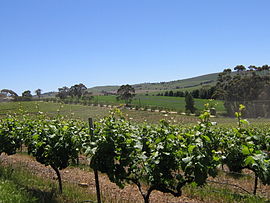Clare Valley
The Clare Valley is a valley located in South Australia about 100 kilometres (62 miles) north of Adelaide in the Clare and Gilbert Valleys council area.[1] It is the river valley formed by the Hutt River but is also strongly associated with the roughly parallel Hill River. The valley is traversed by the Horrocks Highway and the main towns in the valley along that route from south to north are Clare, Sevenhill, Penworthham and Watervale and Auburn. The geographical feature has given rise to the Clare Valley wine region designation, a notable winegrowing region of Australia.[2]
Contents
History[edit]
|
This section needs additional citations for verification. (March 2013) (Learn how and when to remove this template message)
|
Pre-European settlement[edit]
The original inhabitants of the Clare Valley were the Ngadjuri people. It is believed that they had major camping sites at Clare and Auburn, as well as other areas outside the valley.[3]
European settlement[edit]
The first European to reportedly explore the Clare Valley was John Hill, who did so in early April 1839, discovering and naming the Hutt River.[4] Its nearby twin, the Hill River, was later discovered and named in his honour. On returning to Adelaide, he reported his findings of potentially good farmland to his friend and associate, Edward John Eyre. Eyre in turn informed John Horrocks, who had only arrived in South Australia during March 1839. Eyre later explored the Clare Valley on the return journey from his second 1839 expedition to the northern regions of South Australia. Horrocks set out with his servant, John Green and established himself in the area now known as Penwortham.[5] This became the first permanent settlement in the valley. By 1840, Edward Burton Gleeson had set up the Inchiquin pastoral run to the north which was later developed into the town of Clare[6] and in 1848, Jesuits were settling into the place which would become the town of Sevenhill. Settlers came from places including England, Ireland, Poland and Silesia during the 1840s, producing a rich heritage of architecture and villages, which remain largely intact.[citation needed] Vineyards were planted alongside those first villages and winemaking has continued ever since.
Modern times[edit]
On 16 February 1983, the Clare Valley was affected by the Ash Wednesday bushfires. Although there were no fatalities in the area, over 6,100 hectares were burnt out, causing $5 million worth of damage.[7] The railway line between the Clare Showgrounds and Penwortham was severely damaged, and resulted in its eventual demise. The old rail route has since been transformed into a bicycle and walking track known as the Riesling Trail. This 35 km sealed trail links the villages of the valley.
See also[edit]
References[edit]
- ^ a b "Search result for 'Clare Valley, VAL'". Property Location Browser. Government of South Australia. SA0050610. Retrieved 30 June 2017.
- ^ "Clare Valley Wine Region (map)" (PDF). Phylloxera and Grape Industry Board of SA. 26 July 2013. Retrieved 14 November 2014.
- ^ Noye, Robert J. (1980). CLARE – A District History. Hawthorndene, South Australia: Investigator Press. pp. 216–218.
- ^ Stratton, J., (ed) (1986). Biographical Index of South Australians 1836 – 1885 Volume II. Adelaide, South Australia: SA Genealogy and Heraldry Society. p. 741.
- ^ Chittleborough, Jon, "Horrocks, John Ainsworth (1818–1846)", Australian Dictionary of Biography (ANU 2005)
- ^ Australian Heritage website
- ^ "26 years on, Clare remembers Ash Wednesday". ABC North and West SA. Retrieved 2009-06-19.

